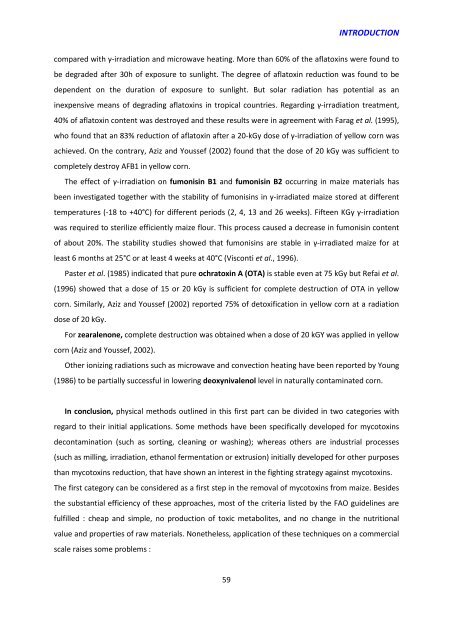Effet chez le porcelet d'une exposition à un régime co-contaminé en ...
Effet chez le porcelet d'une exposition à un régime co-contaminé en ...
Effet chez le porcelet d'une exposition à un régime co-contaminé en ...
You also want an ePaper? Increase the reach of your titles
YUMPU automatically turns print PDFs into web optimized ePapers that Google loves.
INTRODUCTION<strong>co</strong>mpared with γ-irradiation and microwave heating. More than 60% of the aflatoxins were fo<strong>un</strong>d tobe degraded after 30h of exposure to s<strong>un</strong>light. The degree of aflatoxin reduction was fo<strong>un</strong>d to bedep<strong>en</strong>d<strong>en</strong>t on the duration of exposure to s<strong>un</strong>light. But solar radiation has pot<strong>en</strong>tial as aninexp<strong>en</strong>sive means of degrading aflatoxins in tropical <strong>co</strong><strong>un</strong>tries. Regarding γ-irradiation treatm<strong>en</strong>t,40% of aflatoxin <strong>co</strong>nt<strong>en</strong>t was destroyed and these results were in agreem<strong>en</strong>t with Farag et al. (1995),who fo<strong>un</strong>d that an 83% reduction of aflatoxin after a 20-kGy dose of γ-irradiation of yellow <strong>co</strong>rn wasachieved. On the <strong>co</strong>ntrary, Aziz and Youssef (2002) fo<strong>un</strong>d that the dose of 20 kGy was suffici<strong>en</strong>t to<strong>co</strong>mp<strong>le</strong>tely destroy AFB1 in yellow <strong>co</strong>rn.The effect of γ-irradiation on fumonisin B1 and fumonisin B2 occurring in maize materials hasbe<strong>en</strong> investigated together with the stability of fumonisins in γ-irradiated maize stored at differ<strong>en</strong>ttemperatures (-18 to +40°C) for differ<strong>en</strong>t periods (2, 4, 13 and 26 weeks). Fifte<strong>en</strong> KGy γ-irradiationwas required to sterilize effici<strong>en</strong>tly maize flour. This process caused a decrease in fumonisin <strong>co</strong>nt<strong>en</strong>tof about 20%. The stability studies showed that fumonisins are stab<strong>le</strong> in γ-irradiated maize for at<strong>le</strong>ast 6 months at 25°C or at <strong>le</strong>ast 4 weeks at 40°C (Vis<strong>co</strong>nti et al., 1996).Paster et al. (1985) indicated that pure ochratoxin A (OTA) is stab<strong>le</strong> ev<strong>en</strong> at 75 kGy but Refai et al.(1996) showed that a dose of 15 or 20 kGy is suffici<strong>en</strong>t for <strong>co</strong>mp<strong>le</strong>te destruction of OTA in yellow<strong>co</strong>rn. Similarly, Aziz and Youssef (2002) reported 75% of detoxification in yellow <strong>co</strong>rn at a radiationdose of 20 kGy.For zeara<strong>le</strong>none, <strong>co</strong>mp<strong>le</strong>te destruction was obtained wh<strong>en</strong> a dose of 20 kGY was applied in yellow<strong>co</strong>rn (Aziz and Youssef, 2002).Other ionizing radiations such as microwave and <strong>co</strong>nvection heating have be<strong>en</strong> reported by Yo<strong>un</strong>g(1986) to be partially successful in lowering deoxyniva<strong>le</strong>nol <strong>le</strong>vel in naturally <strong>co</strong>ntaminated <strong>co</strong>rn.In <strong>co</strong>nclusion, physical methods outlined in this first part can be divided in two categories withregard to their initial applications. Some methods have be<strong>en</strong> specifically developed for my<strong>co</strong>toxinsde<strong>co</strong>ntamination (such as sorting, c<strong>le</strong>aning or washing); whereas others are industrial processes(such as milling, irradiation, ethanol ferm<strong>en</strong>tation or extrusion) initially developed for other purposesthan my<strong>co</strong>toxins reduction, that have shown an interest in the fighting strategy against my<strong>co</strong>toxins.The first category can be <strong>co</strong>nsidered as a first step in the removal of my<strong>co</strong>toxins from maize. Besidesthe substantial effici<strong>en</strong>cy of these approaches, most of the criteria listed by the FAO guidelines arefulfil<strong>le</strong>d : cheap and simp<strong>le</strong>, no production of toxic metabolites, and no change in the nutritionalvalue and properties of raw materials. Nonethe<strong>le</strong>ss, application of these techniques on a <strong>co</strong>mmercialsca<strong>le</strong> raises some prob<strong>le</strong>ms :59

















